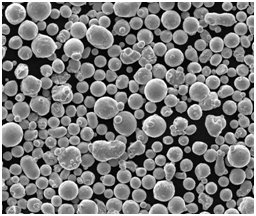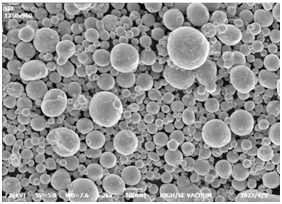لمحة عامة عن معدات الصهر الانتقائي بالحزمة الإلكترونية
الصهر الانتقائي بالحزمة الإلكترونية (EBSM) هي تقنية تصنيع إضافي متقدمة تستخدم حزمة إلكترونية لإذابة مساحيق المعادن بشكل انتقائي، طبقة تلو الأخرى، لإنشاء هياكل ثلاثية الأبعاد معقدة. هذه التكنولوجيا مناسبة بشكل خاص للمواد عالية الأداء والتطبيقات التي تتطلب قوة فائقة ودقة وسلامة المواد. في هذا الدليل الشامل، سوف نتعمق في تفاصيل EBSM، ونستكشف نماذج مسحوق المعادن المختلفة المستخدمة في العملية، ونقدم معلومات مفصلة عن المعدات وخصائصها وتطبيقاتها والموردين.
ما هو الصهر الانتقائي بالحزمة الإلكترونية؟
EBSM هي عملية يتم فيها توجيه حزمة إلكترونية إلى طبقة من مسحوق المعدن، مما يتسبب في ذوبانه وانصهاره معًا. تتكرر هذه العملية طبقة تلو الأخرى حتى يكتمل الجسم ثلاثي الأبعاد النهائي. على عكس طرق التصنيع الإضافي الأخرى، يوفر EBSM دقة وخصائص مادية استثنائية، مما يجعله مثاليًا للصناعات الهامة مثل الفضاء والسيارات والزراعة الطبية.
الميزات الرئيسية لمعدات الصهر الانتقائي بالحزمة الإلكترونية
- دقة عالية: تحقق EBSM دقة عالية وتفاصيل معقدة بسبب التحكم الدقيق في الحزمة الإلكترونية.
- تنوع المواد: قادرة على معالجة مجموعة واسعة من مساحيق المعادن.
- خواص ميكانيكية فائقة: تظهر الأجزاء المنتجة قوة ومتانة ممتازتين.
- تقليل الإجهاد المتبقي: تقلل العملية من الإجهادات الداخلية في المنتج النهائي.
- كفاءة استخدام المواد: معدل استخدام المواد مرتفع مع الحد الأدنى من النفايات.

أنواع مساحيق المعادن للصهر الانتقائي بالحزمة الإلكترونية
يعد اختيار مسحوق المعدن أمرًا بالغ الأهمية في EBSM، لأنه يؤثر بشكل مباشر
نماذج مسحوق المعادن الشائعة لـ EBSM
- Ti-6Al-4V (سبيكة التيتانيوم)
- التركيبة: 6% ألومنيوم، 4% فاناديوم، والباقي تيتانيوم
- الخصائص: نسبة عالية من القوة إلى الوزن، ومقاومة ممتازة للتآكل، وتوافق حيوي
- التطبيقات: مكونات الفضاء الجوي، الغرسات الطبية
- Inconel 718 (سبيكة نيكل-كروم)
- التركيبة: نيكل 50-55%، كروم 17-21%، حديد، كولومبيوم، موليبدينوم
- الخصائص: قوة تحمل عالية لدرجات الحرارة، مقاومة للأكسدة، قابلية لحام جيدة
- التطبيقات: شفرات التوربينات، محركات الصواريخ، المفاعلات النووية
- AlSi10Mg (سبيكة ألومنيوم)
- التركيبة: 10% سيليكون، 0.3% مغنيسيوم، والباقي ألومنيوم
- الخصائص: خفيف الوزن، خصائص حرارية جيدة، نسبة قوة إلى وزن ممتازة
- التطبيقات: قطع غيار السيارات، مكونات الفضاء، هياكل خفيفة الوزن
- فولاذ مقاوم للصدأ 316L
- التركيبة: حديد، 16-18% كروم، 10-14% نيكل، 2-3% موليبدينوم
- الخصائص: مقاومة عالية للتآكل، ليونة ممتازة، خصائص ميكانيكية جيدة
- التطبيقات: الأجهزة الطبية، معدات المعالجة الكيميائية، التطبيقات البحرية
- CoCr (سبيكة كوبالت-كروم)
- التركيبة: 60% كوبالت، 27-30% كروم، والباقي موليبدينوم، نيكل
- الخصائص: مقاومة عالية للتآكل، مقاومة ممتازة للتآكل، توافق حيوي
- التطبيقات: زراعة الأسنان، وزراعة العظام، وزراعة العظام، ومكونات الفضاء الجوي
- الفولاذ المصهور
- التركيبة: 18% نيكل، 8-12% كوبالت، والباقي حديد
- الخصائص: قوة فائقة، متانة ممتازة، قابلية لحام جيدة
- التطبيقات: الأدوات، مكونات الفضاء، تطبيقات عالية القوة
- Hastelloy X (سبيكة نيكل-كروم-موليبدينوم)
- التركيبة: نيكل، 20-23% كروم، 8-10% موليبدينوم، 1.5-2.5% كوبالت
- الخصائص: قوة تحمل ممتازة لدرجات الحرارة العالية، مقاومة للأكسدة
- التطبيقات: محركات التوربينات الغازية، المعالجة الكيميائية، المبادلات الحرارية
- النيوبيوم
- التركيبة: النيوبيوم النقي
- الخصائص: نقطة انصهار عالية، مقاومة ممتازة للتآكل، توافق حيوي جيد
- التطبيقات: الموصلات الفائقة، الأجهزة الطبية، مكونات الفضاء
- النحاس
- التركيبة: نحاس نقي
- الخصائص: توصيل كهربائي وحراري ممتاز، ليونة جيدة
- التطبيقات: المكونات الكهربائية، المبادلات الحرارية، المشعات
- فولاذ الأدوات
- التركيبة: متفاوت (يحتوي عادة على الكربون والكروم والفاناديوم والموليبدينوم)
- الخصائص: صلابة عالية، مقاومة ممتازة للتآكل، متانة جيدة
- التطبيقات: أدوات القطع والقوالب والقوالب والقوالب
خصائص معدات الصهر الانتقائي بالحزمة الإلكترونية
تم تصميم معدات EBSM لتوفير دقة وكفاءة عالية في التصنيع الإضافي. فيما يلي بعض الخصائص الأساسية لهذه المعدات:
المكونات الرئيسية
- مدفع أشعة الإلكترون: تولد وتوجه الحزمة الإلكترونية بدقة عالية.
- غرفة البناء: تحيط بمنطقة البناء، مع الحفاظ على فراغ أو جو خامل.
- موزع البودرة: توزع مسحوق المعدن بشكل موحد عبر منطقة البناء.
- شفرة إعادة الطلاء: تنشر كل طبقة من المسحوق بسلاسة.
- نظام التحكم: تدير معلمات الحزمة الإلكترونية وعملية البناء.
الخصائص الرئيسية
| الخصائص | الوصف |
|---|---|
| حجم البناء | تتراوح عادة من صغيرة (100 مم) إلى كبيرة (1000 مم) في بعد واحد أو أكثر. |
| القرار | دقة عالية مع سمك طبقة يتراوح من 20 إلى 100 ميكرومتر. |
| متطلبات الطاقة | تتطلب طاقة كهربائية كبيرة، غالبًا في نطاق عدة كيلووات. |
| التحكم في الغلاف الجوي | تستخدم فراغًا أو غازًا خاملًا (مثل الأرجون) لمنع الأكسدة والتلوث. |
| تكامل البرمجيات | برنامج متقدم للتصميم والمحاكاة والتحكم، مما يضمن الالتزام الدقيق بنموذج CAD. |
| نظام التبريد | أنظمة تبريد فعالة لإدارة الحرارة المتولدة أثناء عملية الانصهار. |
| توافق المواد | قادرة على معالجة مجموعة واسعة من مساحيق المعادن بما في ذلك التيتانيوم والألومنيوم والفولاذ المقاوم للصدأ وسبائك النيكل. |






تطبيقات معدات الصهر الانتقائي بالحزمة الإلكترونية
تقنية EBSM متعددة الاستخدامات وتستخدم في مختلف الصناعات. فيما يلي بعض التطبيقات الشائعة:
التطبيقات الصناعية
| الصناعة | التطبيقات |
|---|---|
| الفضاء | مكونات المحرك، الأجزاء الهيكلية، الأشكال الهندسية المعقدة، المواد خفيفة الوزن |
| السيارات | أجزاء المحرك، المكونات المخصصة، الهياكل خفيفة الوزن |
| الطبية | غرسات تقويم العظام، وزراعة الأسنان، والأدوات الجراحية |
| الطاقة | شفرات التوربينات، المبادلات الحرارية، مكونات المفاعل النووي |
| الدفاع | الدروع خفيفة الوزن، مكونات الأسلحة، أجزاء الطائرات بدون طيار |
| الأدوات | القوالب والقوالب وأدوات القطع |
| الإلكترونيات | المصارف الحرارية، المكونات الكهربائية، الموصلات |
تطبيقات مفصلة
- مكونات الفضاء: يستخدم EBSM لتصنيع أجزاء الفضاء خفيفة الوزن والمعقدة، مما يقلل من هدر المواد ويعزز الأداء.
- الغرسات الطبية: إن القدرة على إنشاء تصميمات معقدة باستخدام مواد متوافقة حيويًا تجعل EBSM مثاليًا لإنتاج الغرسات المخصصة.
- قطع غيار السيارات: يمكن تصنيع مكونات عالية الأداء وخفيفة الوزن لتعزيز كفاءة استهلاك الوقود والأداء في المركبات.
- قطاع الطاقة: تستفيد شفرات التوربينات والمبادلات الحرارية من القوة العالية ومقاومة درجات الحرارة لأجزاء EBSM المنتجة.
- الأدوات: يتم تصنيع القوالب والقوالب الدقيقة بمتانة استثنائية ومقاومة للتآكل.
مواصفات ومعايير معدات الصهر الانتقائي بالحزمة الإلكترونية
لضمان الجودة والاتساق، يجب أن تلتزم معدات EBSM بمواصفات ومعايير معينة.
مواصفات معدات EBSM
| المواصفات | الوصف |
|---|---|
| حجم البناء | متغير، عادة 200 × 200 × 200 مم إلى 700 × 700 × 400 مم |
| سُمك الطبقة | 20-100 ميكرومتر |
| طاقة الحزمة | 3-10 كيلو واط |
| سرعة المسح الضوئي | حتى 8 م/ث |
| القرار | ± 0.1 مم |
| التحكم في الغلاف الجوي | فراغ أو غاز خامل (مثل الأرجون) |
| البرمجيات | برنامج CAD/CAM متكامل مع المراقبة والتحكم في الوقت الفعلي |
معايير معدات EBSM
| قياسي | الوصف |
|---|---|
| ASTM F3187 | دليل قياسي لعملية التصنيع الإضافي للصهر بالحزمة الإلكترونية |
| ISO/ASTM 52900 | المصطلحات القياسية للتصنيع الإضافي |
| آيزو 13485 | أنظمة إدارة الجودة للأجهزة الطبية |
| AS9100 | أنظمة إدارة الجودة للفضاء |
| آيزو 9001 | معايير إدارة الجودة العامة |
تفاصيل الموردين والأسعار
عند الحصول على معدات EBSM، من الضروري مراعاة الموردين ذوي السمعة الطيبة ومقارنة الأسعار.
قائمة الموردين والتسعير
| المورد | طراز المعدات | نطاق السعر | معلومات الاتصال |
| أركام (GE Additive) | Arcam EBM Q10plus | $500,000 – $1,000,000 | www.ge.com/additive |
| Sciaky Inc. | EBAM 300 Series | $1,000,000 – $2,500,000 | www.sciaky.com |
| رينيشو | RenAM 500E | $600,000 – $1,200,000 | www.renishaw.com |
| Freemelt | Freemelt ONE | $400,000 – $800,000 | www.freemelt.com |
| الصناعات المضافة | ميتال فاب 1 | $800,000 – $1,500,000 | www.additiveindustries.com |
| Xi'an Bright Laser | EP-M250 | $500,000 – $1,000,000 | www.xbmetal.com |
| Aerosint | Multi-Material EBM | $700,000 – $1,400,000 | www.aerosint.com |
| الأنظمة ثلاثية الأبعاد | DMP Flex 350 | $500,000 – $1,200,000 | www.3dsystems.com |
| ترامبف | TruPrint 3000 | $700,000 – $1,300,000 | www.trumpf.com |
| EOS | EOS M 290 | $600,000 – $1,100,000 | www.eos.info |
مقارنة إيجابيات وسلبيات الصهر الانتقائي بالحزمة الإلكترونية
يتمتع EBSM بمزايا مميزة وبعض القيود. هنا، نقارنها لتوفير منظور متوازن.
إيجابيات وسلبيات EBSM
| أسبكت | مزايا | سلبيات |
|---|---|---|
| الدقة | دقة عالية وتفاصيل معقدة | يتطلب تحكمًا ومراقبة دقيقة |
| خواص المواد | خصائص ميكانيكية فائقة، تقليل الإجهاد المتبقي | تقتصر على المواد المتوافقة مع معالجة الحزمة الإلكترونية |
| سرعة البناء | أوقات بناء أسرع مقارنة ببعض طرق التصنيع الإضافي الأخرى | يمكن أن يكون أبطأ بالنسبة للأجزاء الكبيرة جدًا |
| كفاءة المواد | استخدام عالي للمواد مع الحد الأدنى من النفايات | يمكن أن تكون معالجة المسحوق وإعادة تدويره معقدة |
| التكاليف التشغيلية | فعالة من حيث التكلفة للأجزاء عالية القيمة والمعقدة | استثمار أولي وتكاليف تشغيلية عالية |
| التعقيد | قادرة على إنتاج أشكال هندسية معقدة للغاية | تتطلب الخبرة في التصميم ومعلمات العملية |
| المعالجة اللاحقة | بشكل عام، يتطلب معالجة لاحقة أقل مقارنة بالطرق الأخرى | قد لا تزال بعض الأجزاء تتطلب عمليات تشطيب مثل التشغيل الآلي |
| تعدد الاستخدامات | مناسبة لمجموعة واسعة من التطبيقات من الفضاء إلى الطب | غير مناسبة للمواد غير المعدنية |
| التحكم في الغلاف الجوي | يضمن الغلاف الجوي المتحكم فيه أجزاء عالية الجودة بدون أكسدة | قد يكون الحفاظ على الفراغ أو الغلاف الجوي الخامل أمرًا صعبًا من الناحية الفنية |
تحسين هيكل الفقرة لتحسين المشاركة
عند الكتابة عن موضوعات فنية مثل EBSM، من الضروري إبقاء القارئ منخرطًا. دعنا نستكشف كيفية القيام بذلك بفعالية.
استخدام نبرة المحادثة والأسلوب الجذاب
تخيل أنك في حفل عشاء، وتشرح EBSM لصديق مهتم بالطباعة ثلاثية الأبعاد. لن تغوص مباشرة في المصطلحات الفنية، أليس كذلك؟ بدلاً من ذلك، ستبدأ بشيء ذي صلة، مثل، "هل تساءلت يومًا كيف يصنعون تلك الأجزاء المعقدة للغاية لمحركات الطائرات النفاثة؟ حسنًا، هناك هذه التكنولوجيا المذهلة تسمى الصهر الانتقائي بالحزمة الإلكترونية..."
من خلال تقسيم المعلومات المعقدة إلى أجزاء سهلة الهضم واستخدام التشبيهات والاستعارات والأسئلة البلاغية، فإنك تحافظ على اهتمام القارئ. على سبيل المثال، يمكن تشبيه شرح دقة EBSM بـ "الرسم بقلم ذي رأس دقيق مقابل قلم تلوين - الحزمة الإلكترونية هي القلم، مما يمنحك تفاصيل معقدة وحواف ناعمة."

التعليمات
| سؤال | الإجابة |
|---|---|
| ما هي المواد التي يمكن استخدامها مع EBSM؟ | يمكن لـ EBSM معالجة مجموعة متنوعة من مساحيق المعادن، بما في ذلك سبائك التيتانيوم، والسبائك الفائقة القائمة على النيكل، وسبائك الألومنيوم، والفولاذ المقاوم للصدأ، وسبائك الكوبالت والكروم، والمزيد. |
| كيف تقارن EBSM بطرق الطباعة ثلاثية الأبعاد الأخرى؟ | يوفر EBSM خصائص ميكانيكية فائقة ودقة وتقليل الإجهاد المتبقي مقارنة بالطرق مثل SLM (الصهر الانتقائي بالليزر) أو DMLS (التلبيد المباشر للمعادن بالليزر). |
| ما هي التطبيقات الشائعة لـ EBSM؟ | تشمل التطبيقات الشائعة مكونات الفضاء، والغرسات الطبية، وقطع غيار السيارات، ومكونات قطاع الطاقة، والأدوات. |
| هل EBSM مناسب للإنتاج بكميات كبيرة؟ | يستخدم EBSM عادةً للأجزاء المعقدة وعالية القيمة بدلاً من الإنتاج بكميات كبيرة نظرًا لدقته وكفاءة المواد. |
| ما هي المعالجة اللاحقة المطلوبة لأجزاء EBSM؟ | اعتمادًا على التطبيق، قد تتطلب أجزاء EBSM الحد الأدنى من المعالجة اللاحقة، مثل التشغيل الآلي أو التلميع أو المعالجة الحرارية، لتحقيق التشطيب والخصائص المطلوبة. |
خاتمة
يمثل الصهر الانتقائي بالحزمة الإلكترونية تقدمًا رائدًا في التصنيع الإضافي. إن قدرته على إنشاء أجزاء معقدة وعالية الأداء بدقة وكفاءة تجعلها لا تقدر بثمن عبر مختلف الصناعات. من خلال فهم أنواع مساحيق المعادن، وخصائص المعدات، والتطبيقات المتنوعة، يمكننا تقدير الإمكانات التحويلية لتقنية EBSM. سواء كنت مهندسًا أو مصنعًا أو مجرد متحمس للتكنولوجيا، فإن عالم EBSM مليء بالإمكانيات، مما يشكل مستقبل التصنيع حزمة إلكترونية واحدة في كل مرة.

